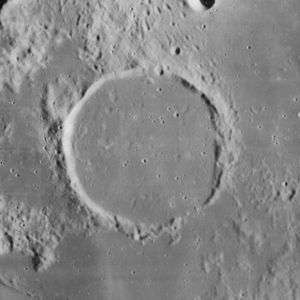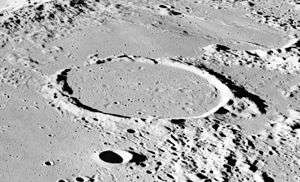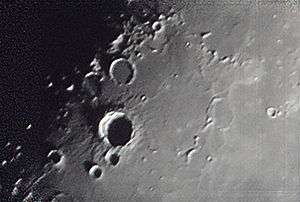Lubiniezky (crater)
 Lunar Orbiter 4 image | |
| Coordinates | 17°48′S 23°48′W / 17.8°S 23.8°WCoordinates: 17°48′S 23°48′W / 17.8°S 23.8°W |
|---|---|
| Diameter | 44 km |
| Depth | 0.8 km |
| Colongitude | 24° at sunrise |
| Eponym | Stanisław Lubieniecki |

Lubiniezky is a lava-flooded lunar impact crater on the northwest edge of Mare Nubium, and is named after Stanisław Lubieniecki.[1] This feature is most readily located by finding the prominent crater Bullialdus to the southeast.
The floor of Lubiniezky has been resurfaced by basaltic lava, which most likely entered from the surrounding mare through the gap in the southeast wall. The surviving rim forms a curved, worn rise around the relatively flat and featureless inner floor. The rim is joined by ridges attached to the north and west walls. To the north of this feature is the bowl-shaped crater Darney. The associated craters Lubiniezky A and E are also flooded, and lie to the northwest. A faint ray from Tycho lies nearly south of the crater rim.
Satellite craters
By convention these features are identified on lunar maps by placing the letter on the side of the crater midpoint that is closest to Lubiniezky.
| Lubiniezky | Latitude | Longitude | Diameter |
|---|---|---|---|
| A | 16.4° S | 25.6° W | 30 km |
| D | 16.5° S | 23.4° W | 8 km |
| E | 16.6° S | 27.3° W | 37 km |
| F | 18.3° S | 21.8° W | 8 km |
| G | 15.3° S | 20.2° W | 4 km |
| H | 17.0° S | 21.2° W | 4 km |
 Lubiniezky E
Lubiniezky E Lubiniezky E (left) and A (right)
Lubiniezky E (left) and A (right)
Notes
- ↑ "Gazetteer of Planetary Nomenclature | Lubiniezky". usgs.gov. International Astronomical Union. Retrieved August 23, 2017.

References
- Andersson, L. E.; Whitaker, E. A. (1982). NASA Catalogue of Lunar Nomenclature. NASA RP-1097.
- Blue, Jennifer (July 25, 2007). "Gazetteer of Planetary Nomenclature". USGS. Retrieved 2007-08-05.
- Bussey, B.; Spudis, P. (2004). The Clementine Atlas of the Moon. New York: Cambridge University Press. ISBN 978-0-521-81528-4.
- Cocks, Elijah E.; Cocks, Josiah C. (1995). Who's Who on the Moon: A Biographical Dictionary of Lunar Nomenclature. Tudor Publishers. ISBN 978-0-936389-27-1.
- McDowell, Jonathan (July 15, 2007). "Lunar Nomenclature". Jonathan's Space Report. Retrieved 2007-10-24.
- Menzel, D. H.; Minnaert, M.; Levin, B.; Dollfus, A.; Bell, B. (1971). "Report on Lunar Nomenclature by the Working Group of Commission 17 of the IAU". Space Science Reviews. 12 (2): 136–186. Bibcode:1971SSRv...12..136M. doi:10.1007/BF00171763.
- Moore, Patrick (2001). On the Moon. Sterling Publishing Co. ISBN 978-0-304-35469-6.
- Price, Fred W. (1988). The Moon Observer's Handbook. Cambridge University Press. ISBN 978-0-521-33500-3.
- Rükl, Antonín (1990). Atlas of the Moon. Kalmbach Books. ISBN 978-0-913135-17-4.
- Webb, Rev. T. W. (1962). Celestial Objects for Common Telescopes (6th revised ed.). Dover. ISBN 978-0-486-20917-3.
- Whitaker, Ewen A. (1999). Mapping and Naming the Moon. Cambridge University Press. ISBN 978-0-521-62248-6.
- Wlasuk, Peter T. (2000). Observing the Moon. Springer. ISBN 978-1-85233-193-1.
External links
- Oblique photo of Lubiniezky A from Apollo 16: AS16-119-19105
